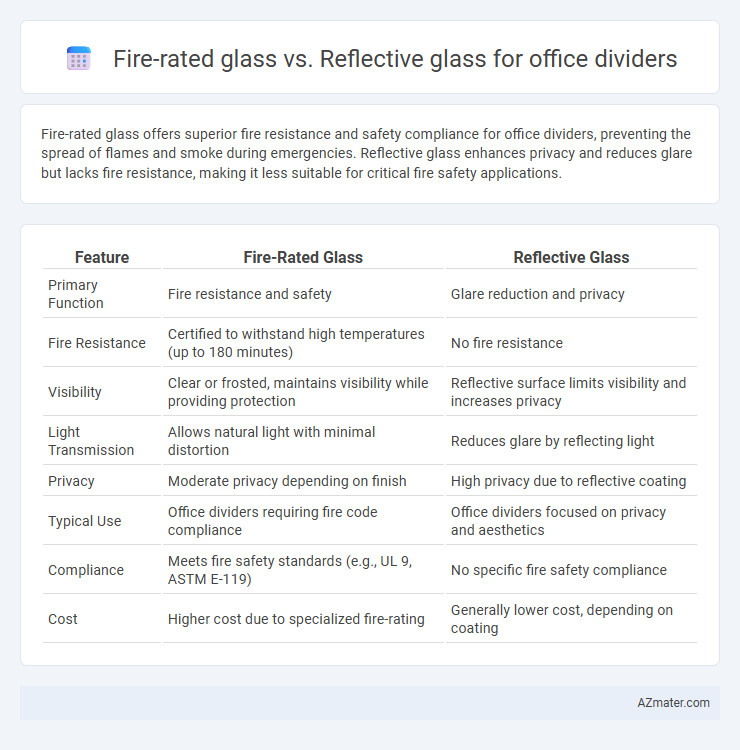Fire-rated glass offers superior fire resistance and safety compliance for office dividers, preventing the spread of flames and smoke during emergencies. Reflective glass enhances privacy and reduces glare but lacks fire resistance, making it less suitable for critical fire safety applications.
Table of Comparison
| Feature | Fire-Rated Glass | Reflective Glass |
|---|---|---|
| Primary Function | Fire resistance and safety | Glare reduction and privacy |
| Fire Resistance | Certified to withstand high temperatures (up to 180 minutes) | No fire resistance |
| Visibility | Clear or frosted, maintains visibility while providing protection | Reflective surface limits visibility and increases privacy |
| Light Transmission | Allows natural light with minimal distortion | Reduces glare by reflecting light |
| Privacy | Moderate privacy depending on finish | High privacy due to reflective coating |
| Typical Use | Office dividers requiring fire code compliance | Office dividers focused on privacy and aesthetics |
| Compliance | Meets fire safety standards (e.g., UL 9, ASTM E-119) | No specific fire safety compliance |
| Cost | Higher cost due to specialized fire-rating | Generally lower cost, depending on coating |
Introduction to Glass Options for Office Dividers
Fire-rated glass offers enhanced safety by withstanding high temperatures and preventing the spread of flames, making it ideal for office dividers in buildings with strict fire regulations. Reflective glass provides privacy and energy efficiency by reducing glare and controlling heat transfer, contributing to a comfortable and stylish workspace environment. Selecting between fire-rated and reflective glass depends on prioritizing safety standards or aesthetic and environmental benefits for office divider installations.
What is Fire-Rated Glass?
Fire-rated glass is specially designed to withstand high temperatures and prevent the spread of flames and smoke, making it essential for office dividers that require enhanced safety and compliance with building codes. This type of glass typically incorporates multiple layers and advanced materials to maintain integrity during fire incidents, ensuring occupant protection and structural stability. Unlike reflective glass, which focuses on privacy and light control, fire-rated glass prioritizes safety without compromising visibility.
What is Reflective Glass?
Reflective glass is a type of architectural glass coated with a thin metallic layer that reduces glare and solar heat transmission, enhancing privacy and energy efficiency in office dividers. Unlike fire-rated glass, which is designed to withstand high temperatures and prevent fire spread, reflective glass primarily focuses on controlling light and improving aesthetics. It offers a sleek, mirror-like appearance while maintaining natural daylight, making it ideal for modern office environments seeking both functionality and style.
Key Differences Between Fire-Rated and Reflective Glass
Fire-rated glass for office dividers is engineered to withstand high temperatures and prevent the spread of fire, meeting strict safety and building code standards, whereas reflective glass primarily enhances privacy and reduces glare by bouncing light away without fire resistance. Fire-rated glass typically contains layers of specialized gels or intumescent materials that expand under heat, while reflective glass features metal coatings that control solar heat gain and improve energy efficiency. Choosing between fire-rated and reflective glass depends on whether fire safety compliance or light control and aesthetic appeal are the primary concerns in office space design.
Safety and Compliance Considerations
Fire-rated glass for office dividers provides critical safety by withstanding high temperatures and preventing fire and smoke spread, complying with building codes such as ASTM E119 and UL 10C. Reflective glass enhances privacy and reduces glare without fire resistance, making it unsuitable for fire protection requirements mandated by OSHA and NFPA standards. Selecting fire-rated glass ensures compliance with stringent safety regulations and contributes to occupant protection during emergencies.
Aesthetic Impacts on Office Design
Fire-rated glass enhances office dividers by providing safety without compromising transparency, maintaining an open and modern aesthetic that promotes natural light flow and spatial connectivity. Reflective glass offers a sleek, contemporary look with its mirror-like finish, adding privacy while controlling glare and heat, which can contribute to a sophisticated, high-tech office ambiance. Choosing between fire-rated and reflective glass depends on balancing safety requirements and design goals, as each impacts the office atmosphere through light management and visual openness.
Light Transmission and Privacy Factors
Fire-rated glass offers high light transmission, typically around 70-80%, while providing critical fire resistance to enhance office safety. Reflective glass reduces light transmission to approximately 30-50%, enhancing privacy by minimizing visibility from outside. Choosing between these glass types depends on balancing natural light needs and the level of privacy required for office dividers.
Cost Comparison: Fire-Rated vs Reflective Glass
Fire-rated glass typically costs 30-50% more than reflective glass due to its specialized fire-resistant materials and certification requirements. Reflective glass offers a more budget-friendly solution while providing enhanced privacy and solar control, making it attractive for office dividers when fire protection is not a priority. Choosing between fire-rated and reflective glass depends on balancing regulatory compliance and safety costs against aesthetic and energy efficiency considerations.
Maintenance and Durability
Fire-rated glass offers superior durability and requires minimal maintenance due to its robust composition designed to withstand high temperatures and prevent fire spread, making it ideal for office dividers that prioritize safety. Reflective glass, while providing enhanced aesthetic appeal and reducing glare, demands more frequent cleaning and careful upkeep to maintain its reflective coating and prevent surface degradation. Both glass types offer distinct maintenance profiles, with fire-rated glass excelling in longevity and resilience under harsh conditions.
Choosing the Right Glass for Your Office Divider
Fire-rated glass ensures enhanced safety by resisting high temperatures and preventing the spread of flames, making it ideal for office dividers in buildings with strict fire codes. Reflective glass offers privacy and reduces glare by bouncing light away, which helps create a comfortable and visually appealing workspace. Selecting the right glass depends on prioritizing either fire protection or privacy requirements within the office environment.

Infographic: Fire-rated glass vs Reflective glass for Office divider
 azmater.com
azmater.com